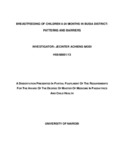| dc.contributor.author | Modi, Jecinter A | |
| dc.date.accessioned | 2016-11-18T08:20:22Z | |
| dc.date.available | 2016-11-18T08:20:22Z | |
| dc.date.issued | 2015 | |
| dc.identifier.uri | http://hdl.handle.net/11295/97548 | |
| dc.description.abstract | INTRODUCTION: Breastfeeding provides infants and young children with nutrients for healthy growth and development. Virtually every mother can breastfeed with the right information and support. Assessment of the local breastfeeding situation is an essential step in developing district specific strategies and programmes to promote breastfeeding and improve child health.
OBJECTIVES: To describe patterns of breastfeeding in children 0-24 months in Busia District. The secondary objectives were to identify barriers to breastfeeding and measures to reduce prelacteal feeding.
METHODOLOGY: This was cross sectional community survey of children 0-24 months and their mothers in Busia District. 385 mother-infant pairs were recruited into the study.An interviewer administered questionnaire was used to obtain data on patterns of breastfeeding (including prelacteal feeding, timely initiation of breastfeeding, exclusive breastfeeding , bottle feeding and continued breastfeeding at one year ). A Focus Group Discussion (FGD) comprising 5 mothers, 2 nurses, 2 grandmothers, 2 community health workers/volunteers and 1 community women leader was held to obtain information on barriers to optimal breastfeeding (exclusive breastfeeding, timely initiation of breastfeeding and prelacteal feeding) and on measures to reduce prelacteal feeding. The households visited were mapped using a hand-held GPS device.
DATA ANALYSIS: Data entry, cleaning and validation were executed using MS Office Excel™. Data analysis was conducted using STATA™ version 12. Means and medians were calculated for the variables as well as their frequencies and percentages. Association between the breastfeeding patterns and maternal characteristics were explored using Chi Square tests. Data from the FGD was analysed using a deductive thematic approach.
Page | xiii
RESULTS: The mean age of the children was 10.6 months (SD 6.7) and 201 (52.2%) were males. 218 (56.6%) of the mothers were between 15 and 24 years. 228 228 228 228 (59.2%) of the mothers were unemployed while 120 (31.2%) were self-employed. About 94% of the mothers attended ANC at least once during pregnancy. The prevalences of the assessed breastfeeding practices were as follows: 85 (78.7%) for exclusive breastfeeding; 189 (51.3%) for timely initiated to breastfeeding ;48 (12.6%) had prelacteal feeds; 67(18.3%) were bottle fed and 42 (84%) continued breastfeeding for at last 1 year. Lack of ANC clinic attendance and lack of breastfeeding information during ANC were associated with increased prelacteal feeding (ten times and four times respectively). The self-employed were twice as likely to exclusively breastfeed OR 2.56 (1.07-6.13) as their salaried counterparts.
Home delivery, non-attendance of ANC clinic, failure to receive information on breastfeeding during ANC visits, maternal engagement outside the home and cultural beliefs were some of the barriers to optimal breastfeeding. Strategies to emphasize ANC clinic attendance, breastfeeding counseling during ANC visits and hospital delivery were cited as some of the measures to reduce prelacteal feeding.
CONCLUSION: The breastfeeding rate in the district was generally high. Even though most children in the district continued to breastfeed for at least one year, there were significant divisional variations. There was a direct relationship between ANC attendance and counseling on breastfeeding during ANC with the practice of optimal breastfeeding. The practice of optimal breastfeeding experienced several barriers including influence by family members, maternal engagement outside the home and myths that surround breastfeeding.
RECOMMENDATION: Breastfeeding messages should emphasise the importance of ANC attendance and breastfeeding counselling during ANC. Programmes to promote breastfeeding should include significant others like grandmothers and be sensitive to local needs. | en_US |
| dc.language.iso | en | en_US |
| dc.publisher | University of Nairobi | en_US |
| dc.rights | Attribution-NonCommercial-NoDerivs 3.0 United States | * |
| dc.rights.uri | http://creativecommons.org/licenses/by-nc-nd/3.0/us/ | * |
| dc.title | Breastfeeding of children 0-24 months in Busia district: patterns and barriers | en_US |
| dc.type | Thesis | en_US |
| dc.description.department | a
Department of Psychiatry, University of Nairobi, ; bDepartment of Mental Health, School of Medicine,
Moi University, Eldoret, Kenya | |



